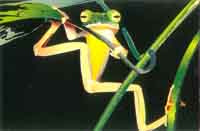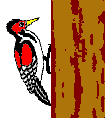Adventure
 'I believe any trip in search of wildlife can be coupled with physical activity and elements of cultural diversity to form a thrilling opportunity ' 'I believe any trip in search of wildlife can be coupled with physical activity and elements of cultural diversity to form a thrilling opportunity '
John H.Eickert
Her father was murdered and she fled. At long last, high in the mountains, she found sanctuary and stayed. In time, the beautiful white, mountain was named for her, the Blessed Goddess, Nanda Devi. The Garhwal area of India holds some of the finest high altitude
trekking in the world. Nearing the end of the third day of my trek into the Nanda Devi Sanctuary the roar from the Rishi Gorge filled the air. The endlessly steep trail makes a wide diversion to the north of this great gorge through rhododendron and deodar
trees. The lucky trekker might see blue sheep or musk deer along the track. At an early morning river crossing one of the porters led me to a feline pugmark in the river sand. It could only have been made by a snow leopard. So close! Maybe, someday! The trek
into Nanda Devi base camp from the west begins in the small village of Lata. A strong trekking team can reach base camp in five to six days.
The camps are named Lata Kharak, Dubrugetha, Ramni, river crossing, and base camp. It is not an easy approach, but well worth it. At base camp, soaring peaks and glistening glaciers surround you. 7816-meter
Nanda Devi dominates the skyline just north of base camp. The air is fresh and brisk. A steady breeze seems to blow at all times. The return trek to Lata is almost as testing as the trek in, but relief can be found at Tapoban hot springs south of Lata along
the road from Joshimath. From the hot springs there is another track heading south and over Kuari Pass. I have not been over this pass and so, hope to return one day. It would be wonderful to be in the Garhwal during the pre-monsoon when the spectacular rhododendrons
are blooming.
Adventures in this area of Uttar Pradesh province begin in Srinagar, which is accessible from Delhi by bus. From Srinagar then take another bus to Joshimath. Joshimath is a fine little village to hire porters and prepare for your trek. The view of Dunagiri
from Lata is magnificent and perhaps a bit intimidating.
Indeed, this entire area is rich in trekking opportunities and Hindu mythology. An avid adventurer could spend a lifetime here. I spent several months and left with a strong yearning to return. In the months ahead, I will recount adventures to Shivling, the
Valley of Flowers, and the epic Milam valley trek. If there were only time to do them all again! There are over a dozen ancient Hindu temples in this area, north of Joshimath lies Badrinath and the ancient trade route to Tibet. If you can remember from a previous
adventure, the Garhwal is also the source of the Ganges, the most holy of rivers. The fall trekking season is upon us and I hope everyone has the chance to get out, take the time, and then take your time. Good adventuring! Cheers.
Visit
http://www.numbum.net or call NumBum Adventurers at 406-777-2228
|
Amazing Facts About Wildlife
Usually, frogs lay their eggs in a suitable habitat and the eggs are left to hatch and develop by themselves. There are some species that have developed "nests" to afford the eggs more protection. The tree frogs of the family Rhacophoridae are one such group.
They are foam nest builders. The male uses his hind legs to whip up the albumen extruded with the eggs into a thick froth. The whole frothy mass ( with the eggs within it) is suspended from a tree or bush above a suitable body of water, into which the tadpoles
will drop when hatched.
The eggs inside the nest are kept moist as the foam nest dries, forming a crust on the outside that is resistant to water loss. The eggs hatch within the nest; the nest liquefies from within as the tadpoles develop and the crust is broken by the liquid mass
at about the time the tadpoles are ready to take to water.
 Tree frogs are widely distributed in India. However a high diversity of species is found only in the wet or hilly areas. The most spectacular member of this family is the Malabar Flying Frog ( Rhacophorus malabaricus) found in the deciduous and evergreen
forests of Kerala, Tamil Nadu and Karnataka. The frog is bright green above with golden yellow sides. Has bright crimson colored webs on fingers and toes. This frog has long toes, all of which are fully webbed. It leaps from trees and extends its fingers and
toes; this action creates a parachute effect at each limb extremity, and allows the frog to glide to another tree. Tree frogs are widely distributed in India. However a high diversity of species is found only in the wet or hilly areas. The most spectacular member of this family is the Malabar Flying Frog ( Rhacophorus malabaricus) found in the deciduous and evergreen
forests of Kerala, Tamil Nadu and Karnataka. The frog is bright green above with golden yellow sides. Has bright crimson colored webs on fingers and toes. This frog has long toes, all of which are fully webbed. It leaps from trees and extends its fingers and
toes; this action creates a parachute effect at each limb extremity, and allows the frog to glide to another tree.
|
Answers To Quiz Of The Month
This month 6 users have give right answers, they are ani_honey06@hotmail.com, dinomaniac@rediffmail.com, j_deshpande@yahoo.com, jvidya@aalayance.com, riyas4you@rediffmail.com, suhaskum@sancharnet.in
Right Answer to
Quiz on Deer and Antelopes
|
| 1.The following mammal does not belong to the family cervidae( deer).
|
|
| 2.Swamp deer found in North India is a subspecies of ............. |
|
barasingha |
chital |
barking deer
|
|
| 3.Though their name means "twelve tined" the stags of this species may develop upto 20 points or more. These mammals are called
|
|
chowsingha |
thamin |
barasingha
|
|
| 4.This species do not shed their antlers every year.
|
|
| 5.Barasingha populations have been restored due to management intervention in
|
|
Corbett N.P |
Kanha N.P |
Nagarhole N.P
|
|
| 6.The most unusual feature of this deer is its alarm call. Which is this species?
|
|
hog deer |
barking deer |
chital
|
|
| 7.This antelope found in India is related to the springbok and the gerenuk in Africa.
|
|
| 8.This animal is better known as the Indian gazelle. .................... |
|
chinkara |
spotted deer |
hog deer
|
|
| 9.These deer are often seen in the company of langurs. ............. |
|
barking deer |
sambar |
chital
|
|
| 10.Chital stags shed their antlers
|
|
during winter |
after the rut season |
during summer
|
|
Please try our quiz for the current month on
Quiz on Frogs and Toads
|
Endangered
compiled by Dr. Susan Sharma
 A close relative of the nightjars, frogmouths are birds that share with them a wide, horny, flat, sharply hooked, boat-shaped bill, but unlike them, do not use it to capture insects on the wing. Asian frogmouth is the common name for small, owllike birds
of the family Podargidae, ranging in size from 9 to 21 in. They feed on crawling animals, such as caterpillars, beetles, scorpions, and centipedes. They fly swiftly, but only over short distances, and the reduced tail feathers limit maneuverability. Nine species
in the genus Batrachostomus are found from India to Malaysia. The remaining three species, in the genus Podargus, are found throughout Australia, New Guinea, and the Solomon Islands. All are nocturnal forest dwellers. Podargus species build flat, twig platform
nests, while species of Batrachostomus make cushions of their own feathers and camouflage them with moss and spiderwebs. Frogmouths lay one or two whitish eggs, which the males incubate by day and the females at night. A close relative of the nightjars, frogmouths are birds that share with them a wide, horny, flat, sharply hooked, boat-shaped bill, but unlike them, do not use it to capture insects on the wing. Asian frogmouth is the common name for small, owllike birds
of the family Podargidae, ranging in size from 9 to 21 in. They feed on crawling animals, such as caterpillars, beetles, scorpions, and centipedes. They fly swiftly, but only over short distances, and the reduced tail feathers limit maneuverability. Nine species
in the genus Batrachostomus are found from India to Malaysia. The remaining three species, in the genus Podargus, are found throughout Australia, New Guinea, and the Solomon Islands. All are nocturnal forest dwellers. Podargus species build flat, twig platform
nests, while species of Batrachostomus make cushions of their own feathers and camouflage them with moss and spiderwebs. Frogmouths lay one or two whitish eggs, which the males incubate by day and the females at night.
National parks ans sanctuaries in the Western Ghats in India are the places to look out for the Sri Lanka Frogmouth. A bird sanctuary wherein documented work exists on the frogmouth is the
Thattekad Bird Sanctuary, also known as the Dr Salim Ali Bird Sanctuary. This is located two hour’s drive from the port city of Kochi, near Kothamanagalam in Ernakulam district, on the northern bank of the Periyar river.
This elusive bird has attracted the attention of film makers too.
"In Quest of the Frogmouth’s nest" - It is Suresh Elamon’s intense affection for nature that made him shoot In Quest of the Frogmouth’s Nest, named after Batrachostomus moniliger, the most elusive bird of the South-Indian tropical
forest. The quest for nature, an unending knowledge for beauty, splendour and solitude illuminate his view.
production :
Suresh Elamon
Birdwing Films Cit Road
Killipalam Trivandrum 695002
India tél.: +91 471 234 35 05
selamon@sancharnet.in
|
Forest and trees
Importance of Indigenous Plants in Indian Mythology and Folklore
Coconut
Botanical Name: Cocos nucifera Sanskrit name: Narikel Hindi Name: Nariyal
The strong winds buffeting the coasts where the graceful coconut palm grows make it impossible to find straight coconut tree, so Indians ensure an additional path to heaven by offering its large, oval nut in their religious rituals. Unripe
coconut fruit is an essential part of all Hindu religious ceremonies. Even in areas where coconut palms do not grow, no puja or offering is complete till a coconut is offered.
 Fishermen offer coconuts to the sea to propitiate Varuna, Lord of Winds and Waters. The coconut is an essential element in wedding ceremonies, often placed in a pitcher of water placed on paddy, a branch of the mango tree is placed in
the pitcher and a coconut adorned with sandal paste, vermilion and flowers is placed on that branch. This is called full pitcher… Purnakumbha, which is symbolically invoked as gods and goddess for the successful end to any mission undertaken. Fishermen offer coconuts to the sea to propitiate Varuna, Lord of Winds and Waters. The coconut is an essential element in wedding ceremonies, often placed in a pitcher of water placed on paddy, a branch of the mango tree is placed in
the pitcher and a coconut adorned with sandal paste, vermilion and flowers is placed on that branch. This is called full pitcher… Purnakumbha, which is symbolically invoked as gods and goddess for the successful end to any mission undertaken.
The coconut is considered by Indians to be the fruit of aspiration, and a guarantee of auspicious beginnings, a coconut is split at the inauguration of any Indian function, from the launching of a ship to the first take of a movie spectacular,
to invite the blessings of god.
The legend connected with its origin, is that Rishi Vishwamitra practiced severe austerities for a long time and in the end acquired super human powers. To prove his prowess, he decided to send Satyavrata to heaven in his earthly body. Satyavrata
had been exiled from his kingdom by his father, for seducing the wife of a citizen. During the period of exile, there was a severe famine and Satyavrata looked after the wife and children of Vishwamitra while the latter was away. Since Satyavrata desired to
reach heaven in his mortal body, Vishwamitra repayed him for having looked after his family by fulfilling his desire and raised him to heaven in his mortal body inspite of strong opposition from sages and gods. When Satyavrata reached Indra’s heaven in his
mortal body, Indra was furious: “How can a mortal reside in my domain in his earthly body? Only souls are permitted.” Feeling annoyed at the audacity of Rishi Vishwamitra, he hurled Satyavrat’s body out of his domain. When Rishi Vsihwamitra saw this, he was
indignant. His very first was coming to naught. For Satyavrata’s body to come back to earth not only meant insult but also an acceptance of defeat at Indra’s hand. So Vishwamitra used his magical power again and stopped the king from falling to the earth.
This resulted in Saytavrata being suspended in air. To prop him Vishwamitra put a pole under him. In course of time, the pole became the coconut palm which is as straight and unbranched as the pole which rishi Vishwamitra had taken to stop his further fall.
Satyavrata remained suspended in the midair and got the epithet Trishanku, one who is neither here nor there. Coconut fruit has a coarse outer fibre covering which symbolically resemble the hair of the king and two prominent black spots on the outside, his
eyes.
Coconut fruit fulfills one desires and is offered to deities. It is also considered as symbol of Lord Shiva because it has three black spots and Shiva has three eyes. In Gujarat, it is said that the bride offers a coconut to her bridegroom
and he preserves it throughout his life. In Mysore, it is worshipped as a family god.
However, the true sacredness of the coconut comes from the spectrum of food and medicine it offers for the use of mankind. High in proteins, minerals and vitamins, and representing an ecosystem complete in itself, the coconut provides milk,
water, cream, oil and hard flesh to Ayurvedic medicine for a variety of cures, from the treatment of burns and restoration of hair growth, to the dissolving of kidney stones and treatment for the heart and blood pressure.
_______________________________________________________________________
Importance of Indigenous plants in Indian Mythology and folklore—Compiled by Ms. Priti Sawant
|
News and Views
News……
 We are devoting the 24th edition of "Wildbytes" to the not so glamorous member of the animal kingdom, the frog. There is an informative quiz, the correct answers to which will be published in our next ezine. There is feature article on the frog and the
endangered bird of the month is called" frogmouth"! Also, our chat topic for October ( 18th at 7.30 pm) will be …" Amphibians". It is time that these bio-indicators of our land got a place under the sun - please be there in the chat room to share our "frog
tales". We are devoting the 24th edition of "Wildbytes" to the not so glamorous member of the animal kingdom, the frog. There is an informative quiz, the correct answers to which will be published in our next ezine. There is feature article on the frog and the
endangered bird of the month is called" frogmouth"! Also, our chat topic for October ( 18th at 7.30 pm) will be …" Amphibians". It is time that these bio-indicators of our land got a place under the sun - please be there in the chat room to share our "frog
tales".
Indianwildlifeclub.com invites articles from members.
As the founder and content aggregator for this website dedicated to bringing people all over the world to the 'Indian Wildlife Club' I need your help. With tightening budgets all around the tech and dot-com market place, IndianWildlifeClub.com is in need of
support from those who love nature and wildlife.
All you need to do is…..write 250+words on your favourite animal contact story, favourite nature spots....or your feelings on conservation of wildlife, environment, trees, your review of a remarkable video/book on Indian wildlife, write up on an NGO which prefers
to do the work quietly outside public gaze, reports of volunteer efforts to protect rivers, trees, wildlife in your area. Send the article along with images ( at least one is a must) to
iwc@indianwildlifeclub.com copy to
susan_sharma@hotmail.com.
Views………….
We have received a number of interesting queries from our readers. Please go through them and respond to the email id given. Will readers respond cc to iwc@indianwildlifeclub.com?
1. From: "David Leonhardt"
To:
Subject: Vultures
I have heard there is a shortage of vultures in India. I am wondering if this is true, what the main cause might be and what the top three or four repercussions are. Also, how serious does IWC see this problem?
This is for an article I am preparing for publication. The theme of the article is that everybody and everything has a purpose and a usefulness. I am a big fan of Mother Nature, so I often use environmental themes. I suspect that the vulture angle is one my
readers will appreciate.
Thank you for whatever information you can provide.
David Leonhardt
2. svatsa1@vsnl.net
Hi!
I'm a student of Class7'A' in FAPS (Frank Anthony Public School)
I just wanted to know How The Peacock Became India's National Bird.
My name is Shreyas.
( We forwrded the query to Mr. Samar Singh of World Pheasants Association, who responded by sending a whole article on the Peacock published by him. )
3. From: TLopez4429@aol.com
Subject: Chiru
To: iwc@indianwildlifeclub.com
Hi, I just watch a Television show about the chiru. I live in Akron, OH., United States.
The show a was watchibn was the ultimate explorer form National Geographic. I understand the need not to buy the shahtoosh shawls. Has anyone tried to capture the Chiru and breed them in captivity??
thanks for the information.
tom lopez
4. From: "Ian Gill"
To:
Subject: Chiru antelope.
I would like to discuss with your people a way to further protect the chiru antelope. Banning the sale and production of the shahtoosh shawl has not prevented its manufacture and sale.
I propose that a natural fibre produced by our family be used as a substitute fibre to replace the chiru wool and take further pressure off its hunting. This fibre is as fine as the chiru, nearly as rare but longer in fibre length.
Are there people in your organization with whom I can discuss this?
( This mail was forwarded to WildLife Trust of India, who are taking up the matter directly with Ian Gill)
5. From: mehta jinesh
Subject: flamingo city
To: iwc@indianwildlifeclub.com
would you please tell me , which place is known as flamingo city,
thanking you
jinesh mehta, jamnagar
Amee~Jinesh
|
Zoo
 |
Toby Ninan retired from Delhi Zoo about two years back. With his varied experiences with the wild animals in the zoo, he is the right person
to direct your queries to. Hear what Ninan has to say about his life and chosen career! |
No matter how humble we may feel or act most of us would certainly like a bit of massaging and uplifting of our egos.
One of the things that gives a 'Zoo Man' a great lift is when he is called out to capture a wild animal that has 'invaded' 'human' habitation. ...Well, monkeys in Delhi do this quite often and may I confess that this happens usually when one is at his lowest
ebb and works miracles on his feeling of well being.
When out to capture a wild animal especially one of the primates all the basic cunning and predatory instincts have to play a great part along with one's skills of using tranquillizing equipment.
A very dejected press photographer came to my office at about 5.00 p.m and told me that he did not get a single picture or story for his news editor and wanted me to razzle up a story for him. Well, a few minutes before his arrival I had received a phone call
from the P.M.O (Prime Minister's Office) telling me to come to the North Block of the Central Secretariat near the P.M's office to capture and take away a somewhat sick monkey who was quite a nuisance around there. I told the press man to follow our car but
if anyone had questioned either of us we were not to show any recognition of the other.
The monkey, a big fat fellow with all the signs of obesity was sitting on the top of a ledge near one of the gates of the P.M's office. When lured with some food, he came out of the building and made himself comfortable on the roof of a cycle stand. A large
number of office staff, security men and curious bystanders were in attendance.
Taking a deep breath I aimed the blow pipe at the animal and blew hard. The dart was true and hit the big fellow on his backside. In about three minutes the cocktail of drugs (big as he was) began to take effect and with a big thud the animal dropped five feet
to the ground. He was sandwiched among some cycles and in a trice my driver and I gathered him together in a gunny sack and dumped him inside the car.
The photographer was not lacking and he would get every bit of the action on film and even helped both of us in the final phase of putting the monkey in the car.
Well the photographer got his story and I got my "man".
The pictures appeared on the fifth page of the newspaper which was read by another newspaper man who gave me an opportunity to fly 3000 miles forth and back along with all V.I.P treatment to capture more monkeys!!
|